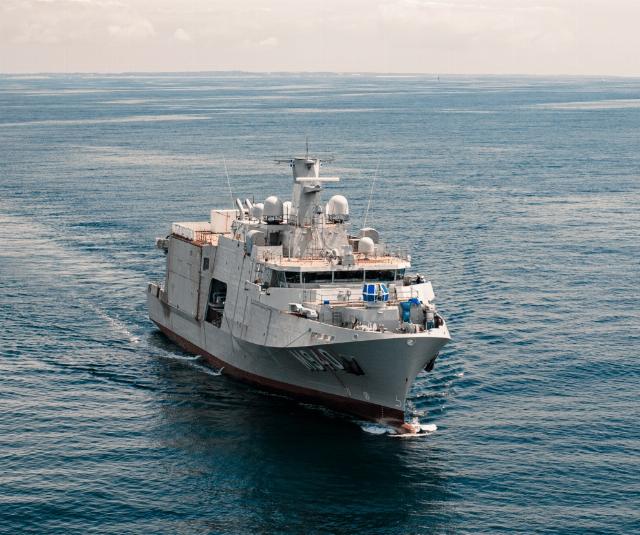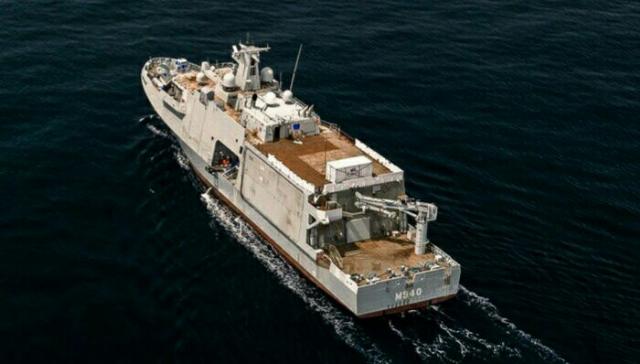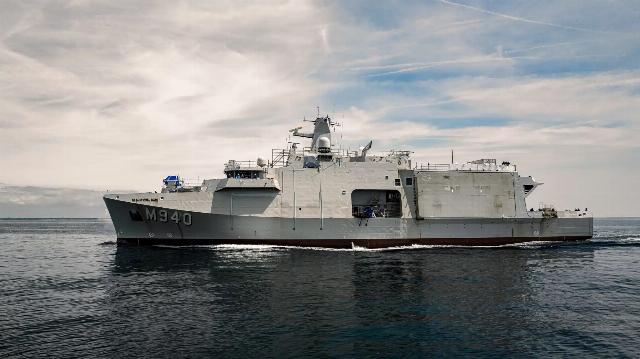It is reported that on July 17, 2024, the lead mine-fighting ship of the new generation M 940 Oostende of the joint Belgian-Dutch Mine Counter Measures (rMCM) program went to sea for factory sea trials from Concarneau in France for the first time. This ship is intended for the Belgian Navy. The ship has not yet been equipped with a mine protection system and its commissioning upon completion of equipment and completion of the full test program is now scheduled for August 2025.

The new generation M 940 Oostende mine warfare headship built for the Belgian Navy by the joint Belgian-Dutch Mine Counter Measures (rMCM) program is being tested, 07/17/2024 (c) Belgium Naval & Robotics
Recall that in May 2019, the consortium Belgium Naval & Robotics, as part of the French shipbuilding association Naval Group and the French group ECA Group (from 2022 called Exail), signed a contract with the Belgian Ministry of Defense (also acting on behalf of the Dutch Ministry of Defense) worth about 2 billion euros for construction for the Belgian and Dutch Navies 12 new generation mine-fighting ships (six units for each of the fleets) under the rMCM program to replace Tripartite-type minesweepers currently in service. 600-ton minesweepers-mine seekers of the joint Franco-Belgian-Dutch Tripartite program were built in the 1980s, when 15 minesweepers were built for the Dutch Navy and ten each for the French and Belgian Navies.
Earlier in March 2019, a preliminary contract for this program was signed by the Ministries of Defense of Belgium and the Netherlands with the announced winner in the relevant tender consortium Belgium Naval & Robotics. The agreement on the joint program of Belgium and the Netherlands for the acquisition of 12 new type mine-fighting ships, as well as on the program for the joint acquisition of four new frigates (two for each of the parties, to replace the M-type frigates) was previously agreed upon by the Governments of Belgium and the Netherlands in November 2016 and finally finalized in early 2018, while the main The role in the mine action program is assigned to the Belgian side.
The general contractor for the construction of anti-mine ships in the Belgium Naval & Robotics consortium is the Naval Group, which carries out their construction as part of the Kership joint venture with the French shipbuilding company Piriou. The latter carries out the direct construction of ships at its shipyards in Concarneau and Lanester under subcontract. The Naval Group is responsible for the design of ships, the overall integration of systems, as well as for the testing of ships, their commissioning and subsequent technical support in operation.
The new mine-fighting ships for the Belgian and Dutch Navies, being built under the rMCM program, are unusually large units with a total displacement of 2,800 tons. The maximum length of the hull is 82.6 m, width 17 m. The cruising range will be more than 3,500 miles, the maximum speed is 15.3 knots and the autonomy is 30 days. The crew is 63 people. The standard armament will consist of a 40 mm BAE Systems Bofors Mk 4 artillery installation and two 12.7mm remotely operated FN Sea deFNder machine gun installations.
The ships will receive a wide range of remotely controlled mine protection systems of the UMIS complex developed by Exail and manufactured by Robotics. In particular, the kit will include automatic underwater vehicles A18-M, towed by GAS T18-M and anti-mine vehicles Seascan and K-ster C, which should be used from two remote-controlled boats Inspector 125 USV placed on board minesweepers. In total, ten sets of mine protection systems should be purchased for 12 ships - a total of 100 underwater vehicles. The mine warfare complex should ensure the fight against any type of sea mines at depths up to 300 m both along the ship's course and over the horizon. In addition, the Inspector 125 USV boats will use towed magnetic and acoustic trawls.
The anti-mine ships will be equipped with integrated mine action control systems MCM Umisoft, which, in turn, will be connected to the control system for unmanned I4 Drones developed by Naval Group. The ships will also be equipped with UAVs of the UMS Skeldar V200 helicopter type.
All 12 ships of the Franco-Belgian rMCM program were named after Belgian and Dutch cities - the Belgian ships were named Oostende, Tournai, Brugge, Liège, Antwerp and Rochefort, and the Dutch - Vlissingen, Scheveningen, Ijmuiden, Harlingen, Delfzijl and Schiedam. Starting in 2025, the Belgian and Dutch fleets should receive one ship per year each. The lead ship M 940 Oostende (construction number C371) is intended for the Belgian Navy. Its construction was carried out at the Piriou company's facility in Concarneau, where it was officially laid down on November 30, 2021 and actually launched on February 22, 2023, the official launching ceremony took place on March 29, 2023. Now it has been put to the test.
The hull of the lead ship for the Dutch Navy M 840 Vlissingen was built at the Piriou shipyard (Kership) in Lanester near Lorian, where it was officially laid down on June 14, 2023 and launched on September 29, 2023, after which the hull was towed for completion to Concarneau, where the official "launching" ceremony took place on October 19, 2023. Its completion is scheduled for the end of 2025. The next five hulls for Dutch ships are to be built under contract by the Romanian shipyard ATG Giurgiu in Giurgiu, and then diverted to Concarneau. Thus, all 12 ships will be completed in Concarneau, and for retrofitting with combat systems and passing tests, they will be diverted from Concarneau to the Naval Group arsenal in Lorian.
The second ship for Belgium, M 941 Tournai, was officially laid down on March 29, 2023 and was launched on June 24, 2024, its delivery is now scheduled for March 2026. The third ship for Belgium, M 942 Brugge, was officially laid down on December 31, 2024, and work has already begun on the fourth Belgian ship, M 943 Liège. The second Dutch ship M 841 Scheveningen was laid down on July 19, 2023, and the third Dutch M 842 Ijmuiden was laid down on June 11, 2024.
On August 30, 2023, France signed a memorandum of accession to the joint Belgian-Dutch rMCM program. According to the memorandum, the basic design of the mine-fighting ship of the Belgian-Dutch rMCM program will be used as the basis for the design of a promising mine-fighting ship under the Bâtiments de guerre des Mines (BDGM) program The French Navy.
It was reported that the French ships, which are supposed to be built under the rMCM / BDGM program, will differ from the Belgian-Dutch anti-mine weapons complex. If the Exail group (former ESA) is the supplier of the mine warfare complex for Belgian and Dutch ships, then the French ones are planned to be equipped with the MLCM mine warfare complex, created under the head role of the Thales group within the framework of the joint Franco-British Système de lutte anti-mines futur / Future Mine Warfare System (SLAM-F / MMCM), and also representing a combination of underwater and surface remotely controlled and autonomous vehicles. Anti-mine ships under the French BGDM program with the MLCM complex will be ordered as part of the second stage of the SLAM-F / MMCM program, with the order of the head unit in 2024 and the transfer to the French Navy in 2028. In total, six of these ships are now planned to be built to replace the remaining Tripartite-type minesweepers in the French Navy. The first stage of the SLAM-F/MMCM program provides for the deployment in 2023-2024 of four MLCM complexes in a containerized land-based version to protect French naval bases.


The new generation M 940 Oostende mine warfare headship built for the Belgian Navy by the joint Belgian-Dutch Mine Counter Measures (rMCM) program is being tested, 07/17/2024 (c) Belgium Naval & Robotics
